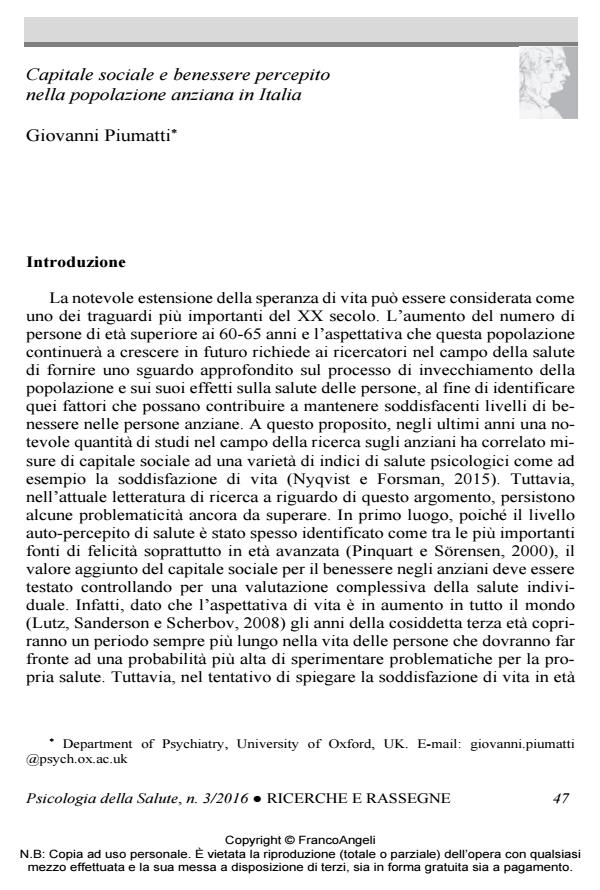Capitale sociale e benessere percepito nella popolazione anziana in Italia
Titolo Rivista PSICOLOGIA DELLA SALUTE
Autori/Curatori Giovanni Piumatti
Anno di pubblicazione 2016 Fascicolo 2016/3
Lingua Italiano Numero pagine 17 P. 47-63 Dimensione file 210 KB
DOI 10.3280/PDS2016-003003
Il DOI è il codice a barre della proprietà intellettuale: per saperne di più
clicca qui
Qui sotto puoi vedere in anteprima la prima pagina di questo articolo.
Se questo articolo ti interessa, lo puoi acquistare (e scaricare in formato pdf) seguendo le facili indicazioni per acquistare il download credit. Acquista Download Credits per scaricare questo Articolo in formato PDF

FrancoAngeli è membro della Publishers International Linking Association, Inc (PILA)associazione indipendente e non profit per facilitare (attraverso i servizi tecnologici implementati da CrossRef.org) l’accesso degli studiosi ai contenuti digitali nelle pubblicazioni professionali e scientifiche
Precedenti ricerche hanno stabilito l’esistenza di un’associazione positiva tra misure di capitale sociale e la soddisfazione di vita tra gli anziani. Questo studio ha lo scopo di ottenere una più profonda comprensione del rapporto tra diverse fonti di capitale sociale e la soddisfazione di vita considerando la valutazione complessiva dello stato di salute auto-percepito. Un campione rappresentativo di 5.613 Italiani di età superiore ai 60 anni è stato estratto dall’indagine Aspetti della vita quotidiana condotta dall’ISTAT nel 2013. Le misure adottate hanno compreso una valutazione auto-percepita del proprio stato di salute insieme a variabili soggettive relative al capitale sociale da un punto di vista sia della collettività che del singolo individuo. Attraverso un’analisi di regressione gerarchica multipla si è osservato come (1) la salute auto-percepita contribuisca in misura maggiore rispetto al capitale sociale a spiegare la soddisfazione di vita e come (2) entrambe le concettualizzazioni di capitale sociale qui analizzate siano associate alla soddisfazione di vita. In particolare, nell’attuale contesto Italiano il capitale sociale individuale appare essere un predittore positivo più determinante della soddisfazione di vita rispetto al capitale sociale collettivo. Tali risultati contengono importanti implicazioni per l’elaborazione di studi futuri e la pianificazione di interventi rivolti alla popolazione anziana in Italia.
Parole chiave:Capitale sociale, anziani, soddisfazione di vita, salute auto-percepita
- The mediation effect of political interest on the connection between social trust and wellbeing among older adults GIOVANNI PIUMATTI, DANIELE MAGISTRO, MASSIMILIANO ZECCA, DALE W. ESLIGER, in Ageing and Society /2018 pp.2376
DOI: 10.1017/S0144686X1700071X - Sospesi nel tempo. Inattività e malessere percepito in giovani adulti NEET Anna Parola, Lucia Donsì, in PSICOLOGIA DELLA SALUTE 3/2018 pp.44
DOI: 10.3280/PDS2018-003003 - Longitudinal Trends in Self-Rated Health During Times of Economic Uncertainty in Italy Giovanni Piumatti, in Social Indicators Research /2020 pp.599
DOI: 10.1007/s11205-019-02207-8
Giovanni Piumatti, Capitale sociale e benessere percepito nella popolazione anziana in Italia in "PSICOLOGIA DELLA SALUTE" 3/2016, pp 47-63, DOI: 10.3280/PDS2016-003003